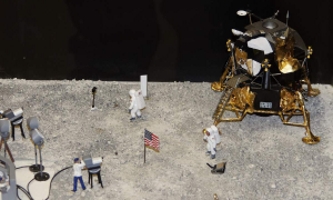No one will even believe this one folks. We here at FENN feel as though we have actually uncovered the proverbial smoking gun of the faked Moon landing. The one thing that no one would have ever even considered, the one tiny and elusive piece of evidence that proves once and for all dramatically that we have yet to take that “… one small step for man…” that sets us down on the Lunar surface and hands us that victory that will offer “… one giant leap for mankind.”
Lots of talk about the camera’s used abounds on the internet, everything from Ed White’s Zeiss to Armstrongs Hasselblad. But little mention of the film even exists anymore. Like most things regarding the Moon missions, the data has been scrubbed from the internet or put back so far on internet search returns that few people can find it. But we here at FENN aren’t so easily swayed… we found it!
The film used aboard Apollo 11 makes for a perfect starting point for this dissertation. Whether or not it was actually used on board the mission that day, who can say. But Polaroid film was certainly around then and we can surmise that it was used, if nothing else the properties of any other film would be similar so we can proceed with Polaroid film.
First off, the film used in the Apollo 11 cam’s was called “Instapack” film, so named because the components required for developing the film are all packed inside the film canister. This material is composed of a breakaway package of liquid emulsion that is flattened out and rolled onto the exposed section of film as it is rolled up. This completes the chemical bath that turns a blank piece of film into a photograph.
Trouble is that this liquid emulsion is highly susceptible to temperature extremes.


Examine the above two photographs taken in minus 17 degrees Fahrenheit. The green tint is very noticeable and all but ruins the shot. If you live in the cold belt you can do this experiment at home.

Now, in contrast, take a look at the crystal clarity of this famous photo of Buzz Aldrin supposedly taken on the Moon by Armstrong’s UNHEATED UNSHIELDED and UNINSULATED Hasselblad EL series off-the-shelf camera, where the temperature in the daytime can range between -100 and 200 degrees F.
Please take note that no green tint caused by freezing of the liquid emulsion has taken place in this image. For this to happen it would require at the least some sort of insulation to protect the Instapack film, at best a full on convection heater system built inside the walls of the camera itself.
According to Polaroid‘s own website:
“keep in mind that our film works best in moderate temperature, between 13 – 28°C (55 – 82°F). Temperatures significantly outside of that range can affect our film in unpredictable ways with respect to development time, color and saturation.”

Difficult to imagine when one is faced with being shown images like the one above with ultra-crystal clarity, isn’t it? In addition Polaroid offers the following advice for low temperature shooting:
“Below 13°C (55°F), photos tend to emerge over-exposed, lacking color contrast and with a green tint. When shooting at lower temperatures, let your images develop in the inside pocket of your jacket or somewhere else close to your body. We also recommend that you carry your camera close to your body in order to keep the film pack and camera at a warm, operational temperature.“
I suppose that they could have made a pouch or something in the space suits where Armstrong and the other Lunar cameramen of fake history could simply follow this advice and shove the camera inside there to keep it warm. But understand that beyond that, there was no other way and no other methods were used.
Learn more about what Polaroid suggests when shooting in cold
A complete history of NASA’s Space photo shoots

